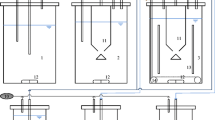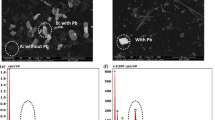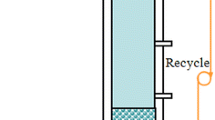Abstract
A mesophilic anaerobic moving bed biofilm reactor (MBBR) was operated to evaluate the effect of sulfate addition on methane production and sulfate reduction using acetate as the sole carbon source. The results show that at the organic loading rate of 4.0 g TOC/L/day, the TOC removal efficiencies and the biogas production rates achieved over 95 % and 7000 mL/L/day without sulfate, respectively, and slightly decreased with sulfate addition (500–800 mg/L). Methane production capacities were not influenced significantly with the addition of sulfate, while sulfate reduction efficiencies were not stable with 23–87 % in the acetate-fed reactor. Fluorescent in situ hybridization (FISH) was used to analyze the functional microbial compositions of acetate-degrading methane-producing bacteria (MPB) and sulfate-reducing bacteria (SRB) in the reactor. The results found that as the increase of sulfate concentration, the proportion of Methanomicrobiales increased up to 58 ± 2 %, while Methanosaeta and Methanosarcina decreased. The dominant methanogens shifted into hydrogenotrophic methanogens from even distribution of acetoclastic and hydrogenotrophic methanogens. When hydrogenotrophic methanogens were dominant, sulfate reduction efficiency was high, while sulfate reduction efficiency was low as acetoclastic methanogens were dominant.







Similar content being viewed by others
References
Amann RI (1995) In situ identification of micro-organisms by whole-cell hybridization with rRNA-targeted nucleic acid probes. In: Kowalchuk GA, de Bruijn FJ, Head IM, Akkermans ADL, van Elsas JD (eds) Molecular microbial ecology manual, 2nd edn. Kluwer Academic Publishers, the Netherlands, pp 1–15
APHA (1999) Standard methods for the examination of water and wastewater. American Public Health Association, Washington
Barbosa LP, Costa PF, Bertolino SM, Silva JCC, Guerra-Sa R, Leao VA, Teixeira MC (2014) Nickel, manganese and copper removal by a mixed consortium of sulfate reducing bacteria at a high COD/sulfate ratio. World J Microbiol Biotechnol 30:2171–2180
Celis-Garcia LB, Razo-Flores E, Monroy O (2007) Performance of a down-flow fluidized-bed reactor under sulfate reduction conditions using volatile fatty acids as electron donors. Biotechnol Bioeng 97:771–779
Crocetti G, Murto M, Bjornsson L (2006) An update and optimisation of oligonucleotide probes targeting methanogenic Archaea for use in fluorescence in situ hybridisation (FISH). J Microbiol Methods 65:194–201
Elferink S, Visser A, Pol LWH, Stams AJM (1994) Sulfate reduction in methanogenic bioreactors. FEMS Microbiol Rev 15:119–136
Fotidis IA, Karakashev D, Angelidaki I (2014) The dominant acetate degradation pathway/methanogenic composition in full-scale anaerobic digesters operating under different ammonia levels. Int J Environ Sci Technol 11:2087–2094
Frankin RJ (2001) Full-scale experiences with anaerobic treatment of industrial wastewater. Water Sci Technol 44:1–6
Harada H, Uemura S, Momonoi K (1994) Interaction between sulfate-reducing bacteria and methane-producing bacteria in UASB reactors fed with low strength wastes containing different levels of sulfate. Water Res 28:355–367
Ikbal, Tang YQ, Fujimura Y, Shigematsu T, Morimura S, Kida K (2003a) The affecting factors for optimization of mesophilic aceticlastic methanogenesis. J Jpn Biol Soc Water Waste 39:189–197
Ikbal, Tang YQ, Shigematsu T, Morimura S, Kida K (2003b) Methanogenic activity and repression on hydrogen sulfide evolved during high rate thermophilic methane fermentation of municipal solid waste. Jpn J Water Treat Biol 39:17–24
Jing ZQ, Hu Y, Niu QG, Liu YY, Li YY, Wang XCC (2013) UASB performance and electron competition between methane-producing archaea and sulfate-reducing bacteria in treating sulfate-rich wastewater containing ethanol and acetate. Bioresour Technol 137:349–357
Khanal SK, Huang JC (2005) Effect of high influent sulfate on anaerobic wastewater treatment. Water Environ Res 77:3037–3046
Kida K, Shigematsu T, Kijima J, Numaguchi M, Mochinaga Y, Abe N, Morimura S (2001) Influence of Ni2+ and Co2+ on methanogenic activity and the amounts of coenzymes involved in methanogenesis. J Biosci Bioeng 91:590–595
Lens PNL, Visser A, Janssen AJH, Pol LWH, Lettinga G (1998) Biotechnological treatment of sulfate-rich wastewaters. Crit Rev Environ Sci Technol 28:41–88
Liamleam W, Annachhatre AP (2007) Electron donors for biological sulfate reduction. Biotechnol Adv 25:452–463
Maillachervu KY, Parkin GF (1996) Kinetics of growth, substrate utilization and sulfide toxicity for propionate, acetate and hydrogen utilizers in anaerobic systems. Water Environ Res 68:1099–1106
Muñoz MA, Sanchez JM, Rodríguez-Maroto JM, Borrego JJ, Moriñigo MA (1997) Methane production in anaerobic sludges supplemented with two support materials and different levels of acetate and sulphate. Water Res 31:1236–1242
Muthumbi W, Boon N, Boterdaele R, De Vreese I, Top E, Verstraete W (2001) Microbial sulfate reduction with acetate: process performance and composition of the bacterial communities in the reactor at different salinity levels. Appl Microbiol Biotechnol 55:787–793
Okabe S, Odagiri M, Ito T, Satoh H (2007) Succession of sulfur-oxidizing bacteria in the microbial community on corroding concrete in sewer systems. Appl Environ Microbiol 73:971–980
Omil F, Lens P, Hulshoff Pol L, Lettinga G (1996) Effect of upward velocity and sulphide concentration on volatile fatty acid degradation in a sulphidogenic granular sludge reactor. Process Biochem 31:699–710
Parkin GF, Lynch NA, Kuo WC, Van Keuren EL, Bhattacharya SK (1990) Interaction between sulfate reducers and methanogens fed acetate and propionate. J Water Pollut Control Fed 62:780–788
Raskin L, Poulsen LK, Noguera DR, Rittmann BE, Stahl DA (1994) Quantification of methanogenic groups in anaerobic biological reactors by oligonucleotide probe hybridization. Appl Environ Microbiol 60:1241–1248
Shigematsu T, Tang YQ, Kawaguchi H, Ninomiya K, Kijima J, Kobayashi T, Morimura S, Kida K (2003) Effect of dilution rate on structure of a mesophilic acetate-degrading methanogenic community during continuous cultivation. J Biosci Bioeng 96:547–558
Shigematsu T, Tang YQ, Kobayashi T, Kawaguchi H, Morimura S, Kida K (2004) Effect of dilution rate on metabolic pathway shift between aceticlastic and nonaceticlastic methanogenesis in chemostat cultivation. Appl Environ Microbiol 70:4048–4052
Silva AJ, Hirasawa JS, Varesche MB, Foresti E, Zaiat M (2006) Evaluation of support materials for the immobilization of sulfate-reducing bacteria and methanogenic archaea. Anaerobe 12:93–98
Silva RC, Rodrigues JAD, Ratusznei SM, Zaiat M (2013) Anaerobic treatment of industrial biodiesel wastewater by an ASBR for methane production. Appl Biochem Biotechnol 170:105–118
Uberoi V, Bhattacharya SK (1997) Sulfate-reducing bacteria in anaerobic propionate systems. J Environ Eng ASCE 123:675–682
Vallero MVG, Trevino RHM, Paulo PL, Lettinga G, Lens PNL (2003) Effect of sulfate on methanol degradation in thermophilic (55 °C) methanogenic UASB reactors. Enzym Microb Technol 32:676–687
Visser A, Hulshoff Pol LW, Lettinga G (1996) Competition of methanogenic and sulfidogenic bacteria. Water Sci Technol 33:99–110
Zhao YG, Wang AJ, Ren NQ, Zhao QS, Zadsar M (2007) Impacts of alkalinity drops on shifting of functional sulfate-reducers in a sulfate-reducing bioreactor characterized by FISH. Chin J Chem Eng 15:276–280
Acknowledgments
This work was supported by National Nature Science Foundation of China (No. 51208324) and Ministry of Education of China (New Century Distinguished Young Scientist Supporting Plan, No. NCET-13-0387).
Author information
Authors and Affiliations
Corresponding author
Rights and permissions
About this article
Cite this article
Yang, SL., Tang, YQ., Gou, M. et al. Effect of sulfate addition on methane production and sulfate reduction in a mesophilic acetate-fed anaerobic reactor. Appl Microbiol Biotechnol 99, 3269–3277 (2015). https://doi.org/10.1007/s00253-014-6235-0
Received:
Revised:
Accepted:
Published:
Issue Date:
DOI: https://doi.org/10.1007/s00253-014-6235-0




